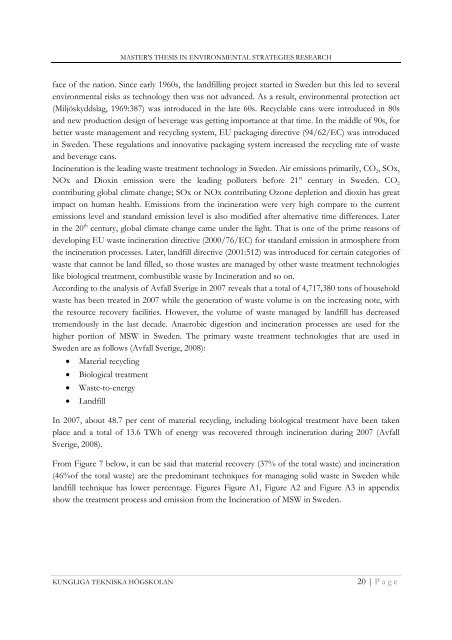Technical Development of Waste Sector in Sweden: Survey
Technical Development of Waste Sector in Sweden: Survey
Technical Development of Waste Sector in Sweden: Survey
You also want an ePaper? Increase the reach of your titles
YUMPU automatically turns print PDFs into web optimized ePapers that Google loves.
MASTER’S THESIS IN ENVIRONMENTAL STRATEGIES RESEARCH<br />
face <strong>of</strong> the nation. S<strong>in</strong>ce early 1960s, the landfill<strong>in</strong>g project started <strong>in</strong> <strong>Sweden</strong> but this led to several<br />
environmental risks as technology then was not advanced. As a result, environmental protection act<br />
(Miljöskyddslag, 1969:387) was <strong>in</strong>troduced <strong>in</strong> the late 60s. Recyclable cans were <strong>in</strong>troduced <strong>in</strong> 80s<br />
and new production design <strong>of</strong> beverage was gett<strong>in</strong>g importance at that time. In the middle <strong>of</strong> 90s, for<br />
better waste management and recycl<strong>in</strong>g system, EU packag<strong>in</strong>g directive (94/62/EC) was <strong>in</strong>troduced<br />
<strong>in</strong> <strong>Sweden</strong>. These regulations and <strong>in</strong>novative packag<strong>in</strong>g system <strong>in</strong>creased the recycl<strong>in</strong>g rate <strong>of</strong> waste<br />
and beverage cans.<br />
Inc<strong>in</strong>eration is the lead<strong>in</strong>g waste treatment technology <strong>in</strong> <strong>Sweden</strong>. Air emissions primarily, CO 2 , SOx,<br />
NOx and Diox<strong>in</strong> emission were the lead<strong>in</strong>g polluters before 21 st century <strong>in</strong> <strong>Sweden</strong>. CO 2<br />
contribut<strong>in</strong>g global climate change; SOx or NOx contribut<strong>in</strong>g Ozone depletion and diox<strong>in</strong> has great<br />
impact on human health. Emissions from the <strong>in</strong>c<strong>in</strong>eration were very high compare to the current<br />
emissions level and standard emission level is also modified after alternative time differences. Later<br />
<strong>in</strong> the 20 th century, global climate change came under the light. That is one <strong>of</strong> the prime reasons <strong>of</strong><br />
develop<strong>in</strong>g EU waste <strong>in</strong>c<strong>in</strong>eration directive (2000/76/EC) for standard emission <strong>in</strong> atmosphere from<br />
the <strong>in</strong>c<strong>in</strong>eration processes. Later, landfill directive (2001:512) was <strong>in</strong>troduced for certa<strong>in</strong> categories <strong>of</strong><br />
waste that cannot be land filled, so those wastes are managed by other waste treatment technologies<br />
like biological treatment, combustible waste by Inc<strong>in</strong>eration and so on.<br />
Accord<strong>in</strong>g to the analysis <strong>of</strong> Avfall Sverige <strong>in</strong> 2007 reveals that a total <strong>of</strong> 4,717,380 tons <strong>of</strong> household<br />
waste has been treated <strong>in</strong> 2007 while the generation <strong>of</strong> waste volume is on the <strong>in</strong>creas<strong>in</strong>g note, with<br />
the resource recovery facilities. However, the volume <strong>of</strong> waste managed by landfill has decreased<br />
tremendously <strong>in</strong> the last decade. Anaerobic digestion and <strong>in</strong>c<strong>in</strong>eration processes are used for the<br />
higher portion <strong>of</strong> MSW <strong>in</strong> <strong>Sweden</strong>. The primary waste treatment technologies that are used <strong>in</strong><br />
<strong>Sweden</strong> are as follows (Avfall Sverige, 2008):<br />
• Material recycl<strong>in</strong>g<br />
• Biological treatment<br />
• <strong>Waste</strong>-to-energy<br />
• Landfill<br />
In 2007, about 48.7 per cent <strong>of</strong> material recycl<strong>in</strong>g, <strong>in</strong>clud<strong>in</strong>g biological treatment have been taken<br />
place and a total <strong>of</strong> 13.6 TWh <strong>of</strong> energy was recovered through <strong>in</strong>c<strong>in</strong>eration dur<strong>in</strong>g 2007 (Avfall<br />
Sverige, 2008).<br />
From Figure 7 below, it can be said that material recovery (37% <strong>of</strong> the total waste) and <strong>in</strong>c<strong>in</strong>eration<br />
(46%<strong>of</strong> the total waste) are the predom<strong>in</strong>ant techniques for manag<strong>in</strong>g solid waste <strong>in</strong> <strong>Sweden</strong> while<br />
landfill technique has lower percentage. Figures Figure A1, Figure A2 and Figure A3 <strong>in</strong> appendix<br />
show the treatment process and emission from the Inc<strong>in</strong>eration <strong>of</strong> MSW <strong>in</strong> <strong>Sweden</strong>.<br />
KUNGLIGA TEKNISKA HÖGSKOLAN<br />
20 | Page
















